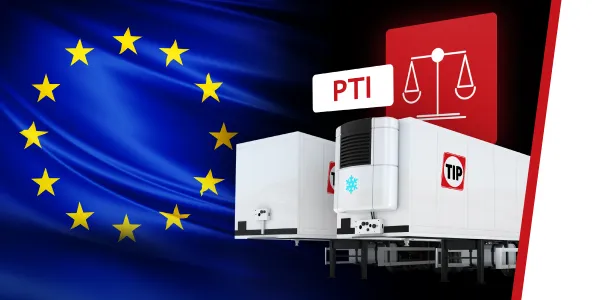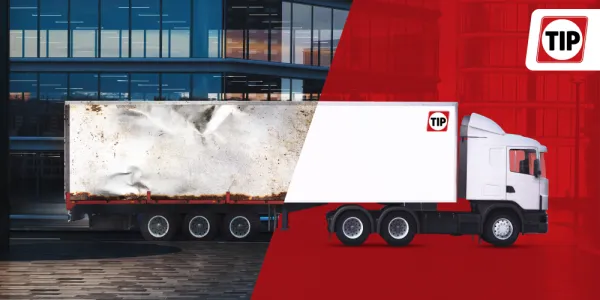No time to wait: Why the energy transition rewards early movers
Why should transport companies start experimenting with sustainable technology today, before the market has fully settled? In this article, Oliver Bange, Vice President Central Region at TIP Group, shares his perspective on why moving early makes business sense. As the lead of TIP Group’s energy transition workstream during the development of its 2030 strategy, Bange argues that the real risk lies not in testing new technology, but in waiting too long to start. Drawing on TIP’s experience across Europe, he outlines the practical and strategic advantages for companies that choose to act now.
"The transport and logistics sector is at a critical juncture," says Oliver Bange, Vice President Central Region at TIP Group. "With sustainability demands mounting and emission regulations tightening, companies are under pressure to rethink their fleets. But for many, a lingering uncertainty over which green technologies will dominate, and the risk associated with making the wrong decision is holding them back. But it's a mistake to wait until we know what the winning technology is."
Experience builds a strategic advantage
Bange explains that the current landscape is full of variables. Governments adjust subsidy schemes with little warning. Regulatory frameworks are fragmented across Europe. And the technologies themselves – battery-electric, hydrogen, gas-powered vehicles – are all in different stages of maturity. Betting on the wrong solution can result in stranded investments, underutilized assets, or compliance risks. But standing still is equally dangerous.
"There’s no one winning technology yet, and it might stay that way," says Bange. "Gas, battery-electric, hydrogen: they all have potential. It really depends on customer’s network, goals, local legislation, and operational context. What works well for urban distribution in the Netherlands, for example, might not work for long-haul operations in Eastern Europe. Every geography, every use case has different requirements."
"That’s why I believe the right approach is to stay open and test different solutions. It’s not about waiting until a clear winner emerges, it’s about understanding which technology fits where, and starting to build experience with it. In the end, it’s not just about the vehicle or the fuel. It’s about the full ecosystem: infrastructure, policy, operations, and people. You need to find out what works best for your business."
The early mover advantage
And according to Bange, the benefits are clear:
"We see that the early adopters are growing. They’re winning new business, steadily increasing the share of greener technology in their fleets – and even their drivers are on board. Everyone was saying the drivers would be reluctant to embrace electric powered equipment. Our experience is actually the opposite. Drivers are excited to operate new equipment. It adds a sense of pride and modernity. They feel they’re part of something important."
"These companies are not just becoming more efficient, they’re shaping the market," says Bange. "If you can show that you're running these new technologies successfully, you're seen as credible. You get more RFQs, and you’re not just responding to tenders, you’re influencing how they’re written. Your experience becomes a reference. You’ve tested it. You’ve got the data. And it works. That shifts the whole conversation. It’s not just about ticking a sustainability box, it’s about positioning your business for growth and long-term relevance in a changing market."

The full picture of sustainable impact
While much of the energy transition discussion focuses on propulsion – what powers the truck – Bange is quick to point out that what the truck hauls is just as critical.
"We always talk about new technologies and energy sources for the vehicle itself, but the trailer side is just as important when you want to look at the full sustainability picture. Sustainability must also come from smarter use of existing equipment. Refurbishing assets and extending their lifecycle is a huge lever. There was a tendency in the industry, and not just in transport, but everywhere, to simply buy new. But that’s not sustainable anymore. Refurbishment brings significant CO2 savings, and financial savings too."
Data and digitization will also shape the next phase. With telematics and smart monitoring systems, companies can gain much better control over trailer (and truck) utilization, performance, and maintenance. These systems help make equipment smarter, enabling predictive maintenance, minimizing downtime, and improving operational efficiency. This, too, is part of sustainability, it’s not only about switching to green technologies, but about using existing assets more intelligently and efficiently.
Lower emissions, higher efficiency through load optimization
"One of the most overlooked areas is load optimization," says Bange. "There is so much potential in making sure trucks and trailers are fully loaded in the smartest possible way. This is where AI can really help, planning, routing, distribution. If we can improve even a few percentage points, that means fewer trips, less fuel, and lower emissions. It’s an area where there’s still a lot to gain, and we need to pay more attention to it if we’re serious about sustainability."
Experimentation is necessary, but lower the stakes
Bange has clear advice for transport companies that are willing but still hesitant to incorporate more sustainable technology in their operations:
"If you have 100 trucks, why not start with three and experiment? That’s just 3% of your fleet. It’s a safe way to gain operational experience without major risk," says Bange. "You don’t need to switch everything at once. Just run a pilot. See how it works. That’s how you build up your own experience. You learn what kind of routes are suitable, how charging really works in your operation, what kind of feedback you get from your drivers. And you do it at a scale that doesn’t threaten your business."
Bange goes on to explain that such pilots are designed around the customer’s operational reality. A cold-chain operator in the Netherlands may begin with e-reefers to comply with low-emission zones, while a regional haulier in Germany might prioritize e-trucks to benefit from toll exemptions and available subsidies.
De-risking through partnership
"What’s unique with TIP is that we’re manufacturer neutral," says Bange. "We offer several configurations, like several types of electric reefers, so customers can choose what works best for them. That flexibility is key."
"We also help lower the investment risk. With leasing or rental models, customers don’t need to commit to long-term ownership when they’re still figuring things out. And because we carry the asset risk, they’re not left with equipment that might turn out to be a poor fit."
"And we’ve worked with many of our customers for years, sometimes decades. There’s a relationship of trust, which means we can have honest conversations, about the risks, the practicalities, and what it really takes to implement new tech.”
Conclusion: you can start small, but start now
In Bange’s view, companies that start now, even with small-scale pilots, position themselves to win in the long run:
"It’s an evolution. In five years, the business model for transport companies might look different because of the technological advances. But if you’ve been part of the journey, you’ll be ready."
"And there will be no perfect moment," says Bange. "The infrastructure isn’t fully ready. The tech is still evolving. The legislation is still changing. But that’s precisely why you need to test, learn, and adapt now. Because the longer you wait, the less prepared you’ll be when we get to the tipping point. And when it comes, those who’ve already built experience will have a clear advantage. They’ll scale faster, respond better, and win more business. So don’t wait for the ideal moment, it won’t come. Start now, even small, and build from there."












